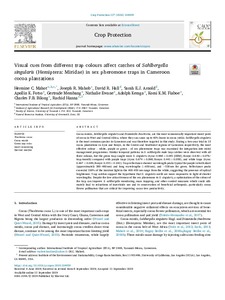| dc.contributor.author | Mahot, H.C. |
| dc.contributor.author | Mahob, J.R. |
| dc.contributor.author | Hall, D.R. |
| dc.contributor.author | Arnold, S.E.J. |
| dc.contributor.author | Fotso, A.K. |
| dc.contributor.author | Membang, G. |
| dc.contributor.author | Ewane, N. |
| dc.contributor.author | Kemga, A. |
| dc.contributor.author | Fiaboe, K.K.M. |
| dc.contributor.author | Bilong, C.F.B |
| dc.contributor.author | Hanna, R. |
| dc.date.accessioned | 2019-12-04T11:36:54Z |
| dc.date.available | 2019-12-04T11:36:54Z |
| dc.date.issued | 2020 |
| dc.identifier.citation | Mahot, H.C., Mahob, J.R., Hall, D.R., Arnold, S.E., Fotso, A.K., Membang, G., ... & Hanna, R. (2020). Visual cues from different trap colours affect catches of Sahlbergella singularis (Hemiptera: Miridae) in sex pheromone traps in Cameroon cocoa plantations. Crop Protection, 127, 1-7. |
| dc.identifier.issn | 0261-2194 |
| dc.identifier.uri | https://hdl.handle.net/20.500.12478/6380 |
| dc.description | Published online: 12 Sept 2019 |
| dc.description.abstract | Cocoa mirids, Sahlbergella singularis and Distantiella theobroma, are the most economically important insect pests of cocoa in West and Central Africa, where they can cause up to 40% losses in cocoa yields. Sahlbergella singularis is the most common species in Cameroon and was therefore targeted in this study. During a two-year trial in 15 cocoa plantations in Ayos and Konye, in the Centre and Southwest regions of Cameroon respectively, the most effective colour – white, purple or green – of sex pheromone traps was examined for integration into mirid management programmes. Similar temporal patterns in S. sahlbergella male trap catches were observed with all three colours, but the green trap caught more S. singularis (Ayos: 0.968 ± 0.091 [SEM]; Konye: 0.640 ± 0.076/trap/month) compared with purple traps (Ayos: 0.674 ± 0.068; Konye: 0.441 ± 0.058), and white traps (Ayos: 0.467 ± 0.049, Konye: 0.253 ± 0.041). Trap reflectance showed wavelength peaks typical for purple in both short (approximately 380–480 nm) and long wavelengths (>650 nm), and ~530 nm for green. Reflectance peaks exceeded 100% of the incident light in the 400–450 nm range from the white, suggesting the presence of optical brighteners. Trap catches support the hypothesis that S. singularis ocelli are more responsive to light of shorter wavelengths. Despite the low attractiveness of the sex pheromone to S. singularis, a optimisation of the colour of the trap can improve S. sahlbergella monitoring, mass trapping, and other control measures which could ultimately lead to reductions of insecticide use and to conservation of beneficial arthropods, particularly cocoa flower pollinators that are critical for improving cacao tree productivity. |
| dc.description.sponsorship | Dutch Development Organization |
| dc.description.sponsorship | German Corporation for International Cooperation GmbH |
| dc.format.extent | 1-7 |
| dc.language.iso | en |
| dc.rights | Copyrighted; all rights reserved |
| dc.subject | Theobroma Cacao |
| dc.subject | Production |
| dc.subject | Plantations |
| dc.subject | Plant Diseases |
| dc.subject | Cameroon |
| dc.title | Visual cues from different trap colours affect catches of Sahlbergella singularis (Hemiptera: Miridae) in sex pheromone traps in Cameroon cocoa plantations |
| dc.type | Journal Article |
| dc.description.version | Peer Review |
| cg.contributor.crp | Roots, Tubers and Bananas |
| cg.contributor.affiliation | International Institute of Tropical Agriculture |
| cg.contributor.affiliation | Institute of Agricultural Research for Development, Cameroon |
| cg.contributor.affiliation | University of Yaoundé |
| cg.contributor.affiliation | University of Greenwich |
| cg.coverage.region | Africa |
| cg.coverage.region | Central Africa |
| cg.coverage.country | Cameroon |
| cg.creator.identifier | Fotso Kuate, A.: 0000-0002-5247-7519 |
| cg.creator.identifier | Rachid Hanna: 0000-0002-5715-0144 |
| cg.researchtheme | PLANT PRODUCTION & HEALTH |
| cg.isijournal | ISI Journal |
| cg.authorship.types | CGIAR and developing country institute |
| cg.iitasubject | Banana |
| cg.iitasubject | Cocoa |
| cg.iitasubject | Plant Health |
| cg.iitasubject | Plant Production |
| cg.journal | Crop Protection |
| cg.howpublished | Formally Published |
| cg.accessibilitystatus | Limited Access |
| local.dspaceid | 108047 |
| cg.targetaudience | Scientists |
| cg.identifier.doi | https://dx.doi.org/10.1016/j.cropro.2019.104959 |

